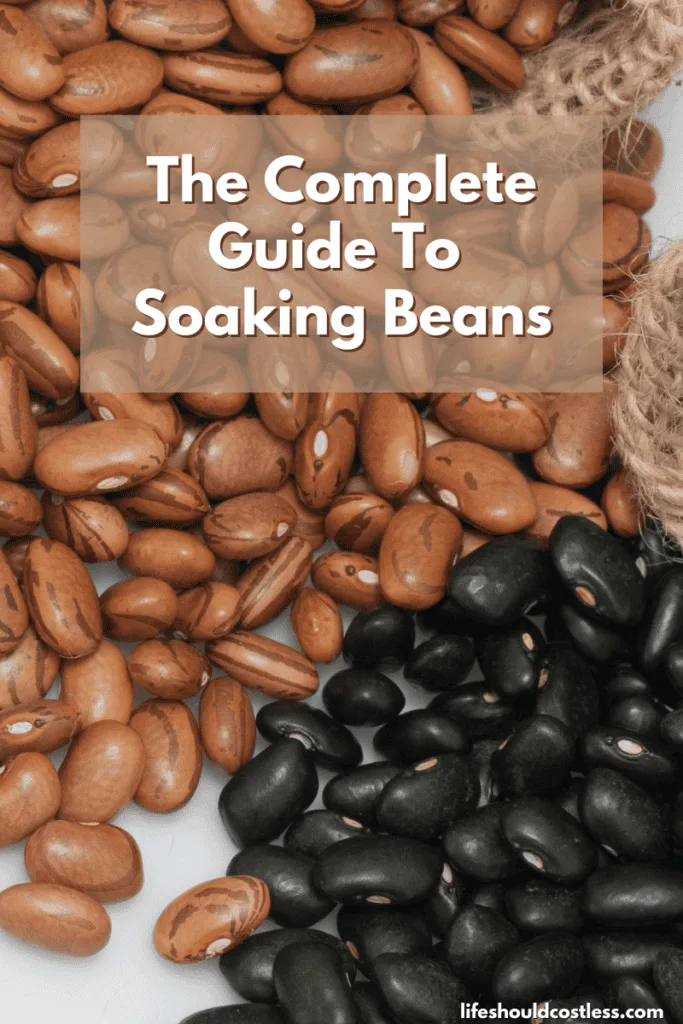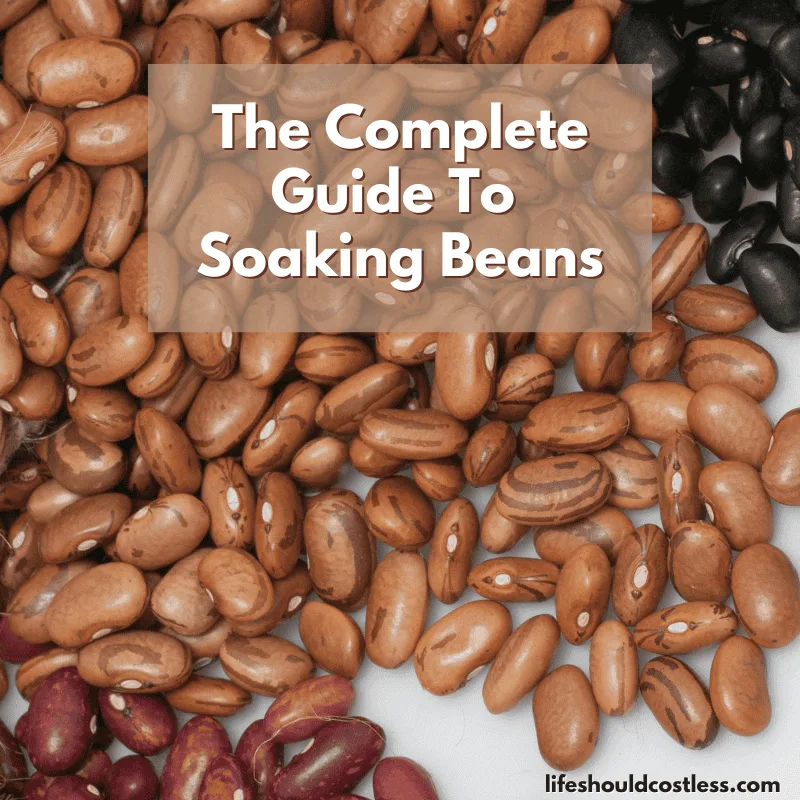Soaking beans is a fundamental step in cooking that can significantly impact the taste, texture, and digestibility of your dishes. This comprehensive guide will walk you through the why, when, and how to soak beans, demystifying the process and providing you with tips to achieve perfectly tender beans every time. From traditional overnight soaks to quick-soaking methods, we’ll cover everything you need to know to make your bean-based recipes a delicious and nutritional success.

Why Should You Soak Your Own beans?
Soaking your own beans offers a multitude of benefits that extend well beyond the kitchen, impacting your health, wallet, and overall culinary experience.
Here are some of the key advantages:
Improved Digestibility
One of the primary benefits of soaked beans is improved digestibility. Beans contain complex sugars called oligosaccharides, which can cause gas and bloating.
Soaking helps break down these sugars, making beans easier on the digestive system.
By allowing beans to soak, you’re giving them time to release some of these compounds into the soaking water, which is then discarded, reducing the likelihood of digestive discomfort…(it may reduce farting…if you didn’t catch my drift…lol).
Enhanced Nutrient Absorption
Soaking can also enhance nutrient absorption.
Beans contain phytic acid, an anti-nutrient that can bind to minerals like iron, calcium, and zinc, preventing your body from absorbing them effectively.
Soaking reduces the phytic acid content, making these essential minerals more bioavailable.
This means that the nutrients in beans are more easily absorbed by your body, contributing to better overall nutrition (see this article for reference).
Reduced Cooking Time
Presoaking beans significantly reduces their cooking time, often by half.
Instead of taking several hours, soaked beans become tender much faster, saving both time and energy.
This makes it easier to incorporate beans into your meals, even on busy days.
Improved Texture and Flavor
Properly soaked beans tend to cook more evenly, resulting in a more consistent texture.
They are less likely to split or become mushy during cooking, which is particularly important for dishes where the appearance and texture of the beans are key, such as in salads or soups.
Additionally, soaking can help beans retain their natural flavor better, contributing to a richer, more satisfying dish.
Cost-Effectiveness
Buying dried beans and soaking them yourself is significantly more cost-effective than purchasing canned beans.
A pound of dried beans can yield the equivalent of several cans, providing considerable savings over time (especially if you’re buying in bulk).
This is especially beneficial for those who consume beans regularly as a protein source or as part of a plant-based diet.
Environmental Benefits
Soaking and cooking your own beans is also more environmentally friendly.
Dried beans have a much lower environmental footprint compared to canned beans.
They require less packaging and reduce the demand for metal cans, which can contribute to waste.
Customization and Control
Soaking and cooking your own beans give you greater control over the final product.
You can adjust the soaking and cooking times to achieve the desired texture, add flavorings such as herbs or spices to the soaking water, and control the amount of salt and other additives.
This level of customization can elevate your dishes and ensure that they meet your dietary preferences and needs.
Variety and Versatility
When you soak your own beans, you have access to a wider variety of beans than typically found canned.
This opens up a world of culinary possibilities, allowing you to experiment with different types of beans, each with its unique flavor, texture, and nutritional profile.
From black beans and kidney beans to chickpeas and lentils, soaking your own beans enables you to diversify your diet and try new recipes.
Preservation of Tradition and Culture
Bean soaking is actually a time-honored tradition in many cultures, passed down through generations.
By soaking your beans, you connect with these culinary traditions and preserve cultural heritage.
It’s a simple yet meaningful way to honor the practices of your ancestors and maintain the authenticity of traditional dishes.
- To see all of my home-making related articles, go here.
- To see all of my emergency prep/ homesteading related articles, go here.
- To see all of my kitchen tips/ food helpers, go here.
How To Prepare Dried Beans For Soaking
Preparing dry beans for soaking involves a few simple steps to ensure they are clean and ready to soak.
Here’s how you can wash and prep beans before soaking:
Sort the Beans
Start by sorting through the dried beans.
Spread them out on a clean surface and remove any debris, small stones, or damaged beans.
This step ensures that you only soak good-quality beans.
Rinse Thoroughly
Place the sorted beans in a colander or strainer.
Rinse them thoroughly under running water.
Use your hands to gently rub the beans, helping to remove any dirt or dust that may be clinging to their surfaces.
Check for Discoloration
As you rinse, check the beans for any discolored or shriveled ones.
Remove these beans as they may not cook evenly and can affect the overall quality of your dish.
Which Soaking Method Is Right For You (& how to do it)
Determining the right bean soaking method depends on several factors, including your available time, the type of beans you’re using, and your desired texture and flavor.
Here’s a guide to help you choose the best soaking method for your needs:
Traditional Overnight Soak
There’s a good video on traditional soaking, found here if you need more of a reference.
Best For:
- Planning ahead
- Most types of beans
- Achieving optimal texture and digestibility
Method:
- Soak beans in water for 8-12 hours (overnight).
Pros:
- Gentle on beans, leading to a better texture.
- Reduces cooking time significantly.
- Reduces oligosaccharides, which can cause gas and bloating.
Cons:
- Requires advance planning.
Quick Soak
Best For:
- When you’re short on time
- Most types of beans
Method:
- Boil beans in water for 2 minutes, then remove from heat and let them soak for 1 hour.
Pros:
- Much faster than the traditional soak.
- Still reduces cooking time and some oligosaccharides.
Cons:
- Beans might not be as tender as with the overnight soak.
- Some nutrients may be lost due to the boiling process.
Hot Soak
Best For:
- Achieving a middle ground between speed and bean texture
- Most types of beans
Method:
- Boil beans for 2-3 minutes, cover, and let soak for 4-5 hours.
Pros:
- Faster than the traditional soak.
- Beans tend to be more evenly hydrated compared to the quick soak.
Cons:
- Requires more attention than an overnight soak.
- Some nutrient loss due to boiling.
No Soak
Best For:
- Lentils, split peas, and other small legumes that cook quickly
- When you prefer a firmer texture
- Convenience when time is not an issue
Method:
- Skip soaking and cook beans directly.
Pros:
- No advance preparation needed.
Cons:
- Long cooking times for larger beans.
- Higher risk of digestive discomfort.
- Inconsistent texture.
Factors To Consider When Choosing A Soaking Method:
Time Available:
- If you can plan ahead, the overnight soak is generally the best option.
- If you need beans quickly, the quick soak method is a good compromise.
Bean Type:
- Larger beans like kidney beans, chickpeas, and black beans benefit from soaking.
- Smaller legumes like lentils and split peas usually don’t require soaking.
Desired Texture:
- For soft and creamy beans, the overnight soak is ideal.
- For beans with a firmer texture, you might prefer the quick soak or no soak methods.
Digestibility:
- For those with sensitive digestion, soaking (especially the overnight method) can help reduce gas and bloating.
By evaluating your specific needs and preferences, you can select the soaking method that will best suit your cooking style and dietary requirements.
Conclusion
In conclusion, soaking beans is a simple yet essential step that can greatly enhance your culinary creations.
By understanding the different methods and their benefits, you can choose the best approach to suit your needs, whether you’re short on time or planning ahead.
Soaking not only improves the texture and flavor of beans but also makes them easier to digest and more nutritious.
With these tips and techniques, you’ll be well-equipped to incorporate delicious wholesome beans into your meals, save money, and making every dish a success.
FAQ’s
Yes, it is possible to soak beans for too long.
If beans are soaked for more than 24 hours, they can start to ferment, which affects their flavor and texture.
Extended soaking can also cause the beans to break down and become mushy, making them less appealing for many dishes.
Additionally, beans soaked for too long may begin to sprout, which can be undesirable for certain recipes.
Refrigerating beans while soaking is generally recommended, especially if you plan to soak them for more than 12 hours.
Soaking beans at room temperature for shorter periods, typically 8-12 hours or overnight, is safe in cooler environments.
However, in warm or humid climates, even shorter soaking times can lead to fermentation and bacterial growth.
Therefore, refrigerating the beans during the soaking process helps maintain a safe temperature and prevents spoilage, ensuring the beans remain fresh and safe for consumption.
*I will add more soaking FAQ’s as the questions get sent to me.
Thanks so much for stopping by my blog and supporting my endeavors to make people’s lives a little easier/better/more affordable.
If you liked this post, or found it helpful in any way, please make sure to share it with your family, friends, and co-workers via social media.
Or you could even send them the direct link via email. Whichever way you choose to spread the love, I super appreciate it! ~Sarah

How To Follow & Support This Site
- If you would like to subscribe to my email list, go here.
- Make sure to follow along via social media, by going here.
- If you would like to learn how to really show your support to this site (at no cost to you), go here.
- If you would like to make a direct donation to the site, go here.
- To see all of my home-making related articles, go here.
- To see all of my emergency prep/ homesteading related articles, go here.
- To see all of my kitchen tips/ food helpers, go here.
Check out my other content
Other prepper / homesteading related articles:
Various kitchen helpers/tips
Other good resources for information on beans
If you found this information useful, here are some other very useful resources that I suggest checking out:
- https://www.loveandlemons.com/how-to-cook-beans/
- https://www.foodandwine.com/how-to-cook-beans-7558107
- https://www.edenfoods.com/cookingtimes
*Please note that this article was originally published to this website on July 12, 2024 and will continually be updated to remain relevant and add any content it may be lacking.
